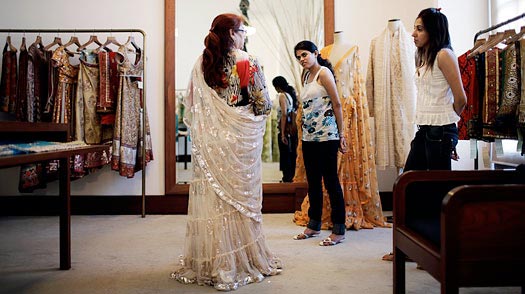Fashion: The Dying Art of the Sari
By Jessica Pudussery | Aug 01, 2009

I am standing in Dilli Haat, New Delhi’s popular open-air handicrafts market, feeling a little guilty. My usual uniform for a hot summer evening — jeans, sandals and a comfortable cotton tunic — is putting people out of business.
“People in Delhi have abandoned their own traditional clothing,” says Bilal Ahmed, 24, a weaver who works for his family business in Jammu and Kashmir. Ahmed and his family specialize in Kadhai work, a type of embroidery. “We have started making more suits and shirts than saris,” he says. “People don’t buy saris anymore. Now they buy jeans.”
Ahmed has been working in the sari business for the past 13 years, during which the popularity of the famous garb has declined drastically in India’s cities. Handloom-weaving is a small-scale business, so there are no comprehensive statistics to track it, but weavers say they’ve noticed a marked decline in the past decade. V.P. Sharma, 48, has been employed as a weaver in the handloom sari industry in Bihar since 1988. He blames the slowdown on women’s changing tastes. It is particularly bad for handloom saris — the simple cotton saris that many Indian women used to wear every day. Their plain designs and muted colors have no appeal for women like Rashmi Raniwal, a 22-year-old sales assistant. “Sari?” she says, giggling. “I never wear it casually, only for formal occasions.”
Sales do pick up in the winter, Delhi’s high season for lavish parties and weddings, but fashionable young women are more interested in designer saris in sheer fabrics made on power looms, not the traditional handwoven silks like the ones in their mothers’ cabinets. “I’m a sari freak,” says Deepa Nangia, 36, a nutritionist. “I love wearing saris for parties and functions, but that’s only designer saris, actually. Who wears traditional saris anymore?” She adds that she is the only one in her circle of friends who has any interest in wearing saris at all. “Youngsters feel like it’s more ‘oldy’ stuff,” she says. “I think it’s just gradually dying out with time.”
The most prized Indian sari styles — Banarasi and Kanjeevaram silks — are also facing new competition. Depending on the intricacy of design, it takes 15 to 30 days to weave one of these saris, which sell for $50 to $60. A Banarasi silk weaver, Abdul Basit Ansari, 37, has been working for the past 20 years weaving these garments, which come from the holy city of Varanasi. “The industry is facing lots of difficulties,” he says. “This is primarily because the sale of fake Banarasi saris made in power looms has been picking up and also because of the sale of cheap imports from China. The government is not stopping this, and our trade is suffering.”
Even in South India, where saris are much more popular than in the north, weavers are having trouble finding a market. Kanjeevaram saris, made in the town of Kanjeevaram, near Chennai, are made by cooperative weaver societies. In 2004, there were 22 weaver societies in Kanjeevaram, but only 13 are left today, according to Business Today. Of these 13, only five say they are doing well. Last year, the 13 weavers sold about $12 million worth of saris, down from $40 million in 2004. The best-known sari shops, like Nalli, which has gleaming showrooms in several big Indian cities, have contracts with some Kanjeevaram weaver co-ops, which is helping them hang on. But it isn’t enough to stop people from fleeing the profession. In and around Kanchipuram, famous for the Kanjeevaram silk saris that hail from this region, the manpower in the weaving industry has gone down drastically, from 60,000 10 years ago to about 20,000 today.
While those dwindling numbers may spell the death of India’s traditional weaving skills, women in Delhi embrace the change as a sign of progress. “There is a general perception that you would consider a woman in Western formal wear more empowered than her more traditional counterparts,” says Kriti Budhiraja, 20, a political science student at Delhi University. And to be fair, the sari industry is not exactly putting up a fight. It’s exiting the stage slowly and almost imperceptibly, with the exception perhaps of Indian soap operas, in which every woman is dressed in an impeccably ironed and draped sari while she cooks and schemes against her mother-in-law. Of course, everyone knows that’s not real life.















